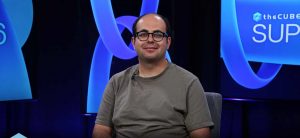Infrastructure and platform categories to be completely obliterated | #RHSummit
![]() At this week’s Red Hat Summit, celebrating its 10th anniversary, co-hosts of SiliconANGLE’s theCUBE, John Furrier and Stu Miniman, welcomed several members of the Red Hat executive team. Early yesterday, Brian Stevens, Executive Vice President and CTO for the company, stopped in to discuss this year’s summit, how the open source community will effectively erase any delineation between infrastructure and platform, converging them into one idea, and how he sees the role of open source in a world becoming increasingly data-centric.
At this week’s Red Hat Summit, celebrating its 10th anniversary, co-hosts of SiliconANGLE’s theCUBE, John Furrier and Stu Miniman, welcomed several members of the Red Hat executive team. Early yesterday, Brian Stevens, Executive Vice President and CTO for the company, stopped in to discuss this year’s summit, how the open source community will effectively erase any delineation between infrastructure and platform, converging them into one idea, and how he sees the role of open source in a world becoming increasingly data-centric.
For those who follow the Red Hat Summit, you know the previous few years saw the conference in Boston. Stevens commented how bringing the summit out west this year really opened Red Hat to a new, wider audience. And many in this new audience had one thing on their minds: OpenStack. Furrier asked Stevens, as EVP and CTO of Red Hat, to share the top conversation he found he was having with both the public, and also with customers and partners.
“The top conversation,” Stevens began, “is actually starting to get kind of boring, honestly. It’s always about OpenStack. It’s nice to mix it up once in a while. But the reality is that it’s a good problem to have.”
Stevens went on to say that perhaps not every conversation started focused on OpenStack, but near every conversation ended there. “That’s the destination that most in the industry say ‘that’s our path forward’ because it’s about Cloud. And Amazon’s not exactly sharing their intellectual property.” Stevens sees OpenStack as a means for customers to achieve an Amazon-like model.
Watch the interview in its entirety here:
.
Start-ups, noted Furrier, love Amazon because, “…you can jump right in there. They have no legacy. It’s a green field for them.” He continued, “You’ve got auto-scaling and all this greatness going on in there. With OpenStack, is that going to be something we’re going to see?”
When Two Become One
.
That specific future is really an unknown. “That remains to be seen,” Stevens responded. That uncertainty, according to Stevens, stems from his belief the whole landscape of the environment is going to look a lot different fairly soon.
“The whole infrastructure category and platform category are going to be completely obliterated,” Stevens said. “It’s going to become one. You could name a million services that Amazon has. Are they infrastructure services or are they platform services? Who the hell cares. It all needs to be one.”
He claims Red Hat and the open source community are going to be the drivers of this imminent convergence, saying, “We’re going to drive, in our case it’s OpenShift, but we’re going to drive the convergence of that with OpenStack. You end up with a better mousetrap.”
Stevens sees Big Data as soon becoming a major play for Red Hat, their partners and the open source community. However, its relative youth in the market means effective strategies are not necessarily available for non-web scale companies.
“It’s certainly one of the hottest areas but I think that there hasn’t been this exact recipe or science on it yet,” he said. “If you have to have a data scientist, that’s a fact of just how not well understood it is.”
He credits advancement in the field to those web scale companies that are taking in a rich supply of daily data, and acting upon it. “Traditional corporations are still in that BI phase,” he stated. “They’re actually looking to figure out how to store, secure and scale out data and really analyze it.” He’s sees the industry moving in that direction. They just aren’t there yet.
What’s Next For Open Source
.
Red Hat has been committed to open source and the community since its inception. Miniman, noting more and more companies are reaching outside their own walls to find innovation, asked Stevens if he could speak to the current state of innovation and to share what excites him the most right now.
“What excites me most about what is happening now,” Stevens stated, “is that innovation is actually starting in open source. I have trouble thinking of a whole category of innovation that is starting in proprietary or owned by one company.” Stevens went on to explain that the explosion of interest around containerization is what most excites him today. “It’s funny that it is technology that has been around forever but it’s just sort of that awareness that has been happening now, that just happened overnight,” he said. “It’s making people realize there is another model out there.”
Devotees of theCUBE often hear Furrier ask the guest, as a final question, to put a bumper sticker on the car that is driving away from the conference. Stevens wryly responded, “Four day weekend.” Of course, he went on to say how he believes the summit is important because it is a great vehicle for putting open source on the road, allowing it to reach a whole new set of people and get them involved.
photo credit: Ѕolo via photopin cc
A message from John Furrier, co-founder of SiliconANGLE:
Your vote of support is important to us and it helps us keep the content FREE.
One click below supports our mission to provide free, deep, and relevant content.
Join our community on YouTube
Join the community that includes more than 15,000 #CubeAlumni experts, including Amazon.com CEO Andy Jassy, Dell Technologies founder and CEO Michael Dell, Intel CEO Pat Gelsinger, and many more luminaries and experts.
THANK YOU









